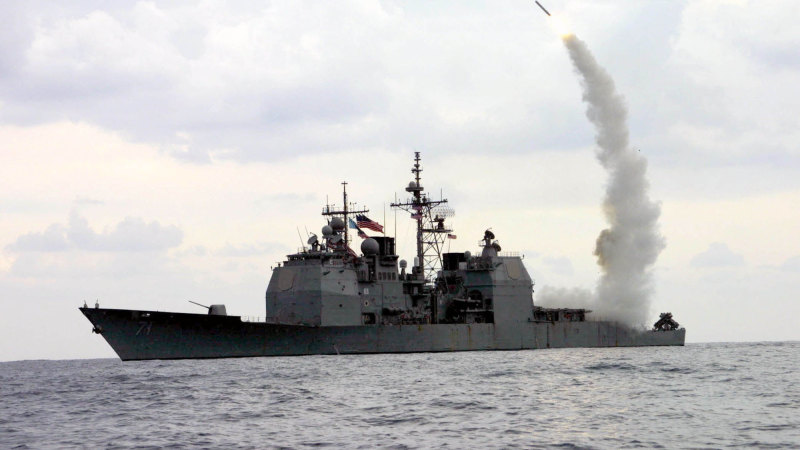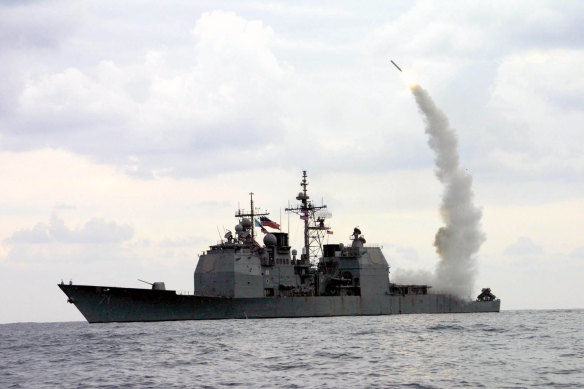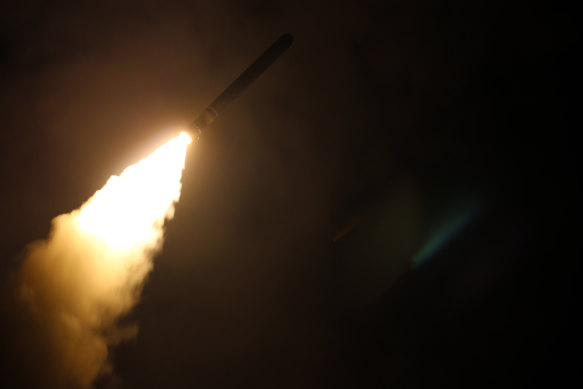Save articles for later
Add articles to your saved list and come back to them any time.
Australian navy ships will be equipped with missiles capable of striking targets 1500 kilometres away in a $3 billion boost to the nation’s long-range firepower designed to deter potential adversaries from encroaching on Australian territory.
The Albanese government will announce on Monday that it is acquiring over 200 Tomahawk cruise missiles from the United States, making Australia just the third nation to secure the highly potent weaponry.
Over 200 Tomahawk land attack missiles will be deployed on Australian navy vessels.
The missiles, manufactured by defence giant Raytheon, will be deployed on the navy’s Hobart-class air warfare destroyers at a cost of $1.3 billion.
The long-awaited purchase comes as the government announced it would also double the amount of high mobility rocket launchers it is purchasing from the US at a cost of $1.6 billion.
The government will also spend $430 million to acquire more than 60 extended-range anti-radiation guided missiles from the US to be operated on the air force’s Growler and Super Hornet aircrafts.
A further $50 million will be spent on equipping the army’s Boxer combat reconnaissance vehicles with Spike Long-Range 2 anti-tank guided missiles.
Defence Minister Richard Marles said the purchase of “formidable long-range strike missiles” showed the government was moving quickly to deliver on the recommendations of the defence strategic review, released in April.
“We are investing in the capabilities our Defence Force needs to hold our adversaries at risk further from our shores and keep Australians safe in the complex and uncertain world in which we live today,” he said.
“The war in Ukraine has demonstrated the importance of having not just war stocks, but a domestic missile manufacturing industry and this announcement will help deliver that.”
The government described the Tomahawks as a “world-leading strike missile capability, with a range of 1500 kilometres” although some military analysts believe they could strike targets over 2000 kilometres away.
A Tomahawk missile fired by the US Navy in 2018.Credit: US Navy
The Morrison government announced the plan to purchase Tomahawks when it revealed the AUKUS pact with the US and United Kingdom in September 2021.
The US State Department approved the sale of up to 220 Tomahawks to Australia in March.
“Australia is one of our most important allies in the Western Pacific,” the US Defence Security Cooperation Agency said.
“The strategic location of this political and economic power contributes significantly to ensuring peace and economic stability in the region.”
Defence Minister Richard Marles said the government is implementing the findings of the defence strategic review.Credit: Alex Ellinghausen
Some doubt about the Tomahawk purchase emerged in late April when Marles said that “the focus is not on that in the immediate term” and described the missiles as “something that we will consider over the journey”.
Defence Industry Minister Pat Conroy said: “As we enter what many are calling the missile age, these will be vital tools for the Australian Defence Force to do its job of defending Australians.
“We are buying these weapons now to deliver capability quickly, but we are also considering options to manufacture missiles domestically because of the importance of building sovereign Australian defence manufacturing capabilities.”
Strategic Analysis Australia director Peter Jennings, a former head of strategy at the Defence Department, praised the Tomahawk purchase, saying: “This will provide a strike range to the navy it has not had for a long time and offer a genuine sense of deterrence to potential adversaries.”
The US Congress on Saturday gave approval for Australia to acquire an extra 22 High Mobility Artillery Rocket System (HIMARS) launchers on top of the 20 announced in January.
The government hopes the system will eventually be used to fire precision strike missiles with a range of 500 kilometres.
HIMARS has been hailed by one analyst as the “new god of war” because of its success on the battlefield in Ukraine.
The defence strategic review called on the government to pursue “an enhanced long-range strike capability in all [military] domains” because advances in defence technology had reduced the benefits of Australia’s remote island geography.
Cut through the noise of federal politics with news, views and expert analysis. Subscribers can sign up to our weekly Inside Politics newsletter here.
Most Viewed in Politics
From our partners
Source: Read Full Article




